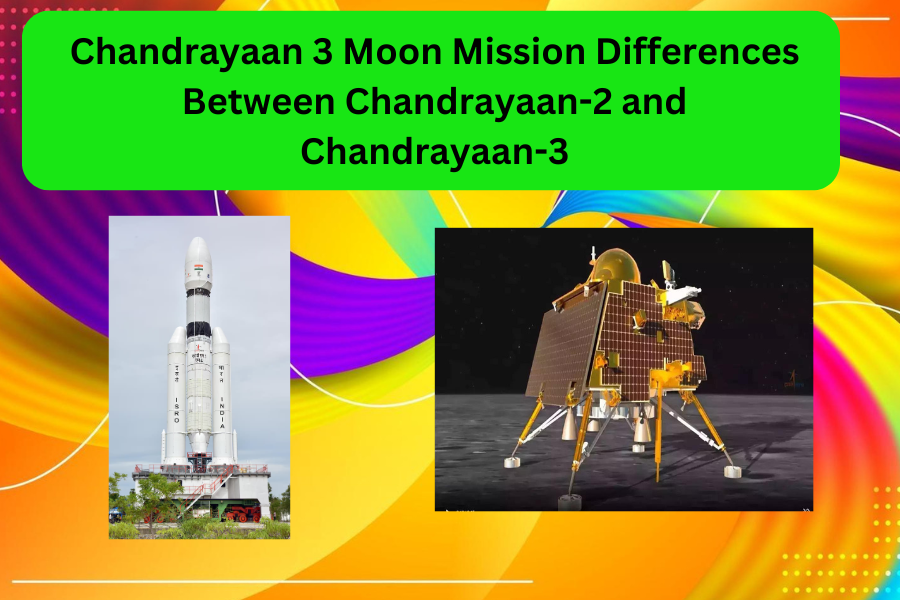Chandrayaan 3 Moon Mission Differences Between Chandrayaan-2 vs Chandrayaan-3
Chandrayaan 3 Moon Mission : On July 14, 2023, ISRO’s LVM3-M4 rocket was launched from Sriharikota carrying Chandrayaan 3 at 2:35 am. At 4:15 both the rockets had left Chandrayaan 3 in space. After a journey of about 40 days, Chandrayaan 3 will reach the lunar surface. With the soft landing of Chandrayaan-3, India will become the fourth country to achieve this feat.
Chandrayaan-3 is the third mission in the Chandrayaan series after the successes of Chandrayaan-1 and Chandrayaan-2.
Objective of Mission Chandrayaan-3 –
- Leading the country towards progress.
- Bringing India to the fourth position on the soft landing of Chandrayaan-3.
- Chandrayaan – 3 aims to land the lander safely on the lunar surface, after landing the rover will roll out for experiments, propulsion module along with the lander, a more than a month long journey to reach the lunar orbit after gaining momentum But will proceed till it reaches 100 km above the lunar surface.
- The scientific objectives of Chandrayaan-3 include studying the distribution and abundance of lunar water and minerals, mapping the lunar terrain in high resolution, and probing lunar seismic activity. The mission also aims to enhance India’s technological capabilities in space exploration including precision landing and autonomous navigation.
- The scientific objectives of Chandrayaan-3 include studying the distribution and abundance of lunar water and minerals, mapping the lunar terrain in high resolution, and probing lunar seismic activity.
- Through Chandrayaan-3, the Indian Space Research Organization (ISRO) seeks to foster international cooperation, share scientific data and contribute to the global lunar research effort. Additionally, this ambitious endeavor aims to encourage youth to pursue scientific pursuits and space To inspire and engage in exploration, which will strengthen India’s position in the global space community.
Features of Mission Chandrayaan-3 –
- The scientific payloads on the lander are aimed at studying various aspects of the lunar environment. These payloads include studying lunar earthquakes, surface thermal properties, changes in plasma near the surface, and precise measurements of the distance between the Earth and the Moon.
- A new experiment called Spectro-Polarimetry of Habitable Planet Earth (SHAPE) has been carried out in the propulsion module of Chandrayaan-3.
- Lunar Lander: Like its predecessor Chandrayaan-2, Chandrayaan-3 is expected to have a lander component designed to perform a soft landing on the lunar surface. The lander will likely carry scientific instruments and experiments to study the lunar environment.
- Rover: Chandrayaan-3 may include a rover to explore the lunar surface close to the landing site. The rover will be equipped with instruments to analyze soil samples, perform surface imaging and gather data on the Moon’s geology.
How is it different from the previous mission?
Chandrayaan 3 Moon Mission ISRO Chairman S Somanath said the changes made in the new mission are actually “failure-based”. “Instead of success-based design in Chandrayaan-2, we are doing failure-based design in Chandrayaan-3, we are looking at what can go wrong and how to deal with it,” he said. During Chandrayaan-2, the rover and lander crashed into the lunar surface, instead of landing softly.
hfh
The chairman explained that the main issue behind such a landing was that the five engines on the lander had slightly more thrust than expected.
fhh
To locate the landing site, the lander had to remain stable during that time and click pictures. That’s when these mistakes happened. However, the current mission has been designed keeping all these errors in mind.
The first change that is worth noting is that the landing area has been expanded. Instead of attempting to reach a designated area of 500 m x 500 m for landing like the previous Chandrayaan-2, the current mission is directed to make a safe landing anywhere within an area of 4 km x 2.4 km.
Chandrayaan 3 Moon Mission One aspect that comes to mind is the landing site. Chandrayaan-2 landed on the near side of the moon, while Chandrayaan 3 is designed to land on the south pole of the moon. The south pole is a very important place for lunar exploration, as it is believed to be rich in water ice.
Finally Chandrayaan 3 will be a more autonomous mission than Chandrayaan-2. The lander and rover on Chandrayaan 3 will be able to operate more independently and no human intervention will be possible after landing on the moon.
Chandrayaan 3 Moon Mission, Chandrayaan-2 vs. Chandrayaan-3
| Feature | Chandrayaan-2 | Chandrayaan-3 |
| Launch Date | July 22, 2019 | July 14, 2023 |
| Mission Components | Orbiter, Lander (Vikram), Rover (Pragyan) | No Orbiter, Lander (Vikram), Rover (Pragyan) |
| Landing Objective | Soft landing on the lunar surface | Soft landing on the lunar surface |
| Landing Site | Plain approximately 600 km from the south pole | South Pole of Moon |
| Software Glitch | Communication lost due to a software glitch | NA |
| Orbiter’s Role | Studying the Moon’s atmosphere, surface mapping, etc. | Studying the Moon’s atmosphere, surface mapping, etc. |
| Objective | Exploring the Moon and expanding lunar knowledge | Focused on spectral and polarimetric measurements of Earth to assess habitability of exoplanets |
| Launch Vehicle | Geosynchronous Satellite Launch Vehicle Mark III (GSLV Mk III) | Geosynchronous Satellite Launch Vehicle Mark III (GSLV Mk III) |
Chandrayaan 3 Moon Mission Chandrayaan-3, the follow-up mission to Chandrayaan-2, is scheduled to be launched on July 14, 2023, nearly four years after the launch of Chandrayaan-2 on July 22, 2019. Both missions are significant attempts by the Indian Space Research Organisation (ISRO) to explore the Moon. While Chandrayaan-3 is expected to replicate some aspects of Chandrayaan-2, there are notable differences between the two missions.
Category : Blog
Follow On
| Click Here | |
| Click Here | |
| Youtube | Click Here |
| Telegram | Click Here |


